Complete Solutions to Solved Problems of chapter AROMATIC COMPOUNDS AND ALKYL AND ARYL HALIDES of Class 12 book with complete answers and questions
| Class 12 | CHEMISTRY |
| Chapter | AROMATIC COMPOUNDS AND ALKYL AND ARYL HALIDES |
| CENGAGE CHEMISTRY | Solved Problems |
| Number Of Questions | 37 |
| Academic Year | 2023-24 |
Complete the following reactions:
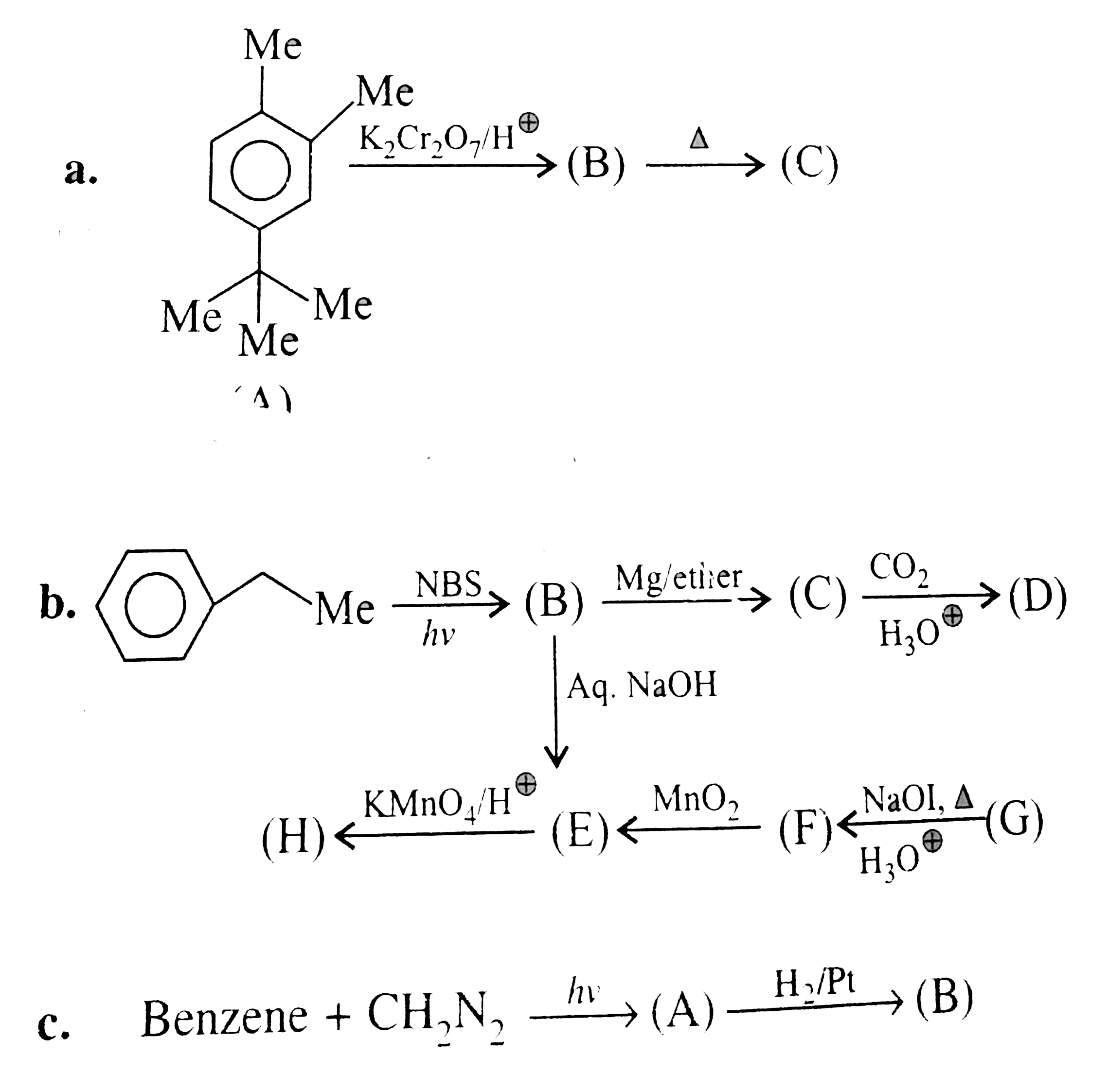 View Solution
View SolutionCycloocta `-1,3,5,7-` tetrane `(A)`, a non-armatic compound reacts with `2` mol potassium to from a stable compound `(B)` without producing. `H_(2)`. Write the structure of `(B)` and explain the reason for its stability.
View SolutionSelect the aromatic, anti-aromatic, and non-aromatic compounds.
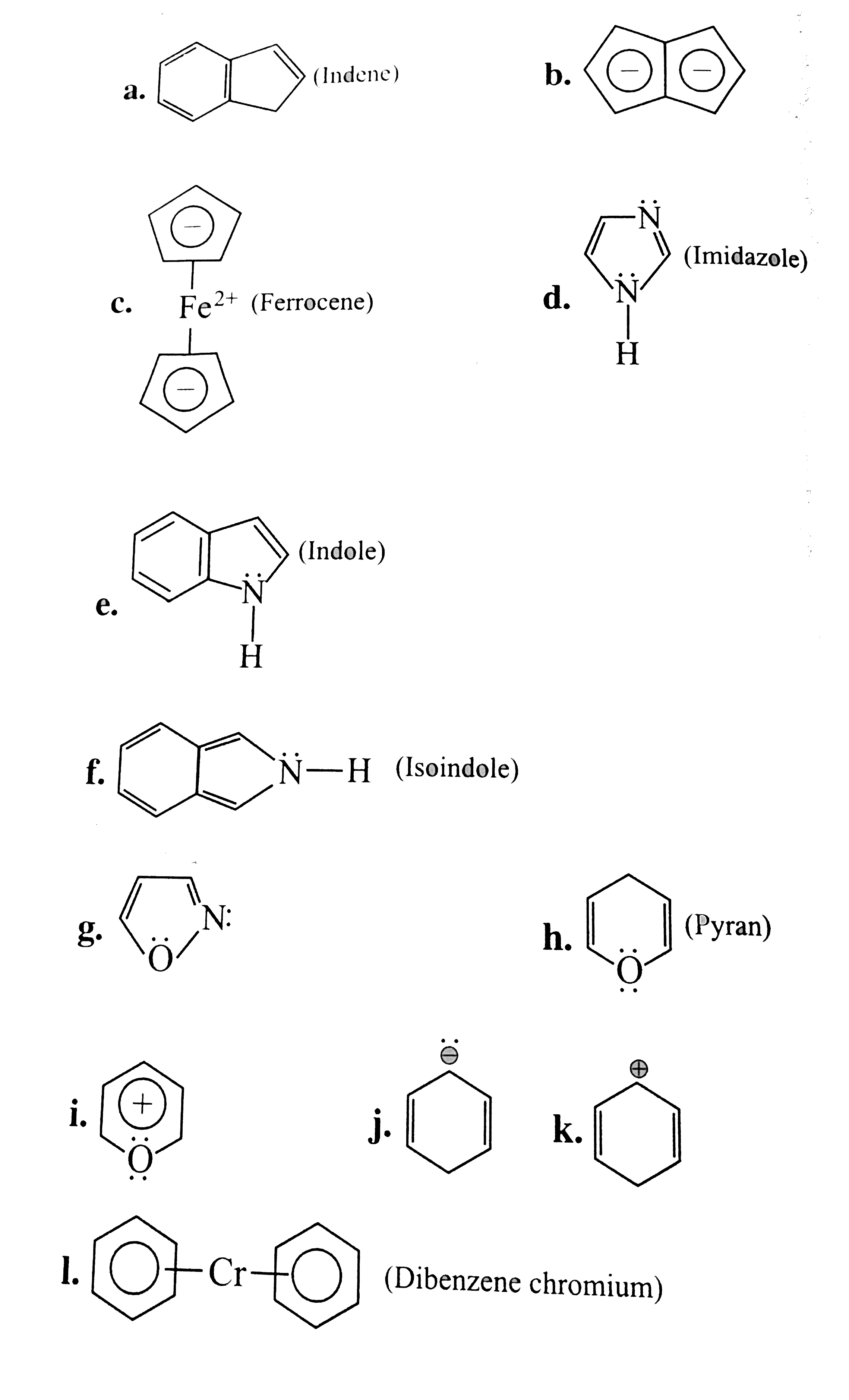 View Solution
View SolutionAnswer the following :
a. Which of the following `H` will have lower `pK_(a)` value in the given compound?
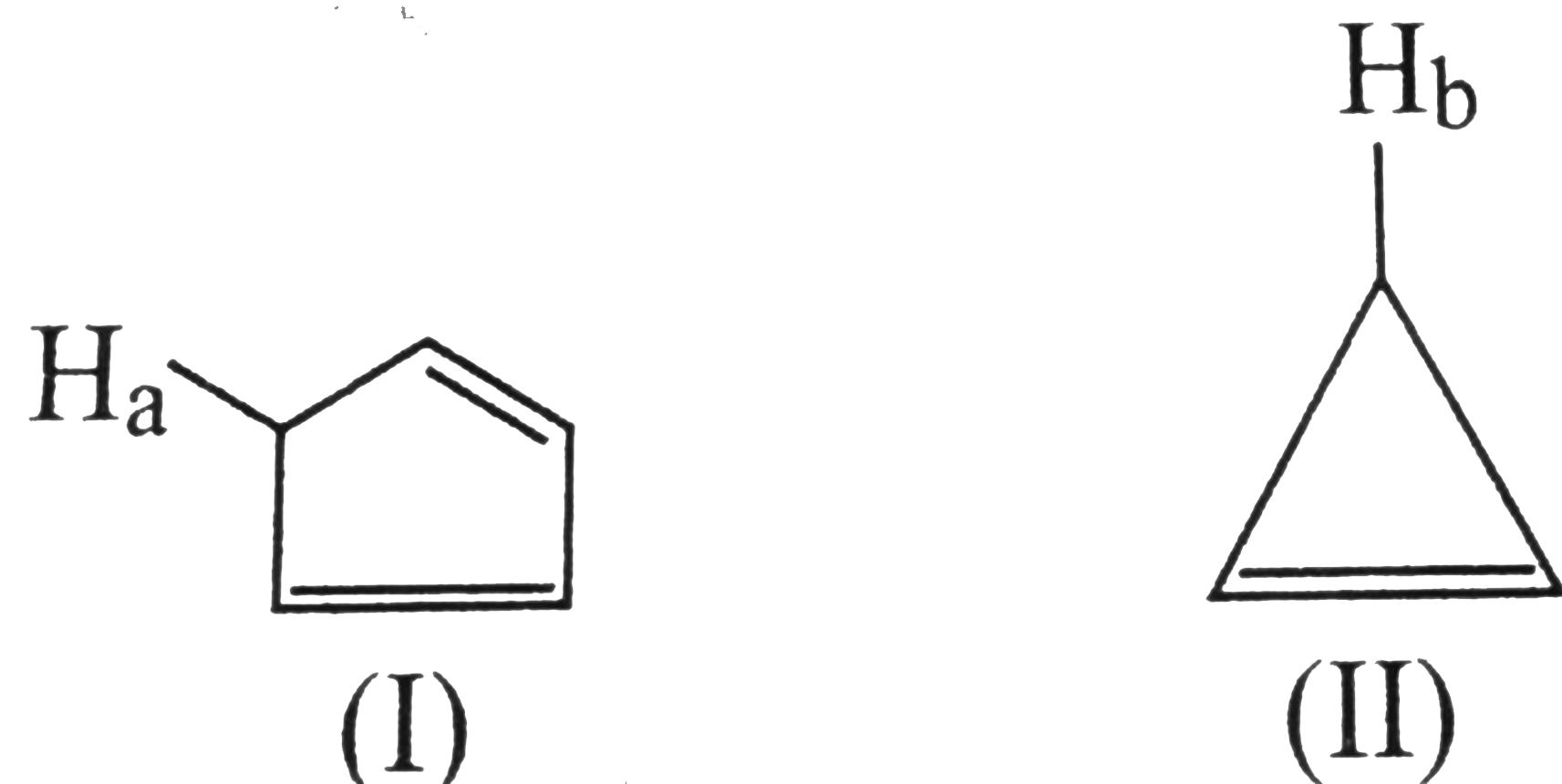
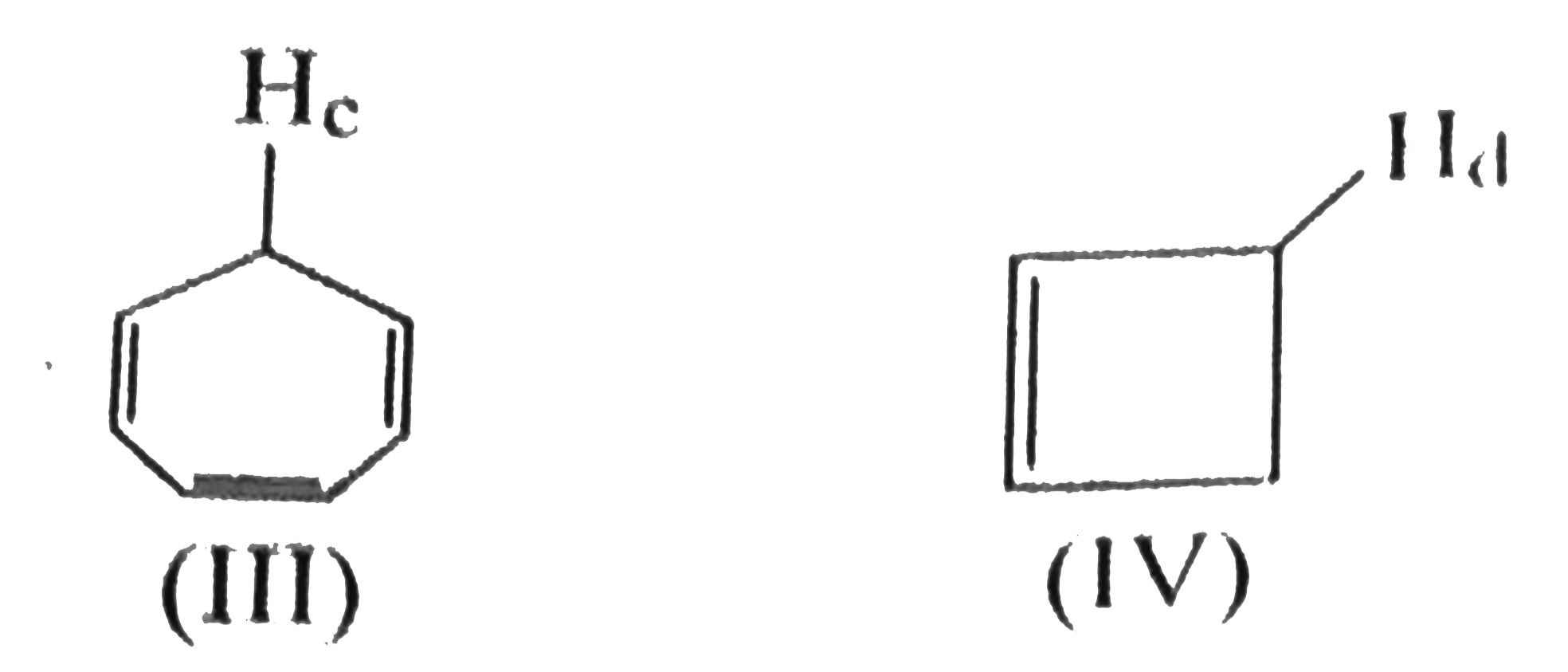
b. Which of the following have lower `pk_(b)` value?
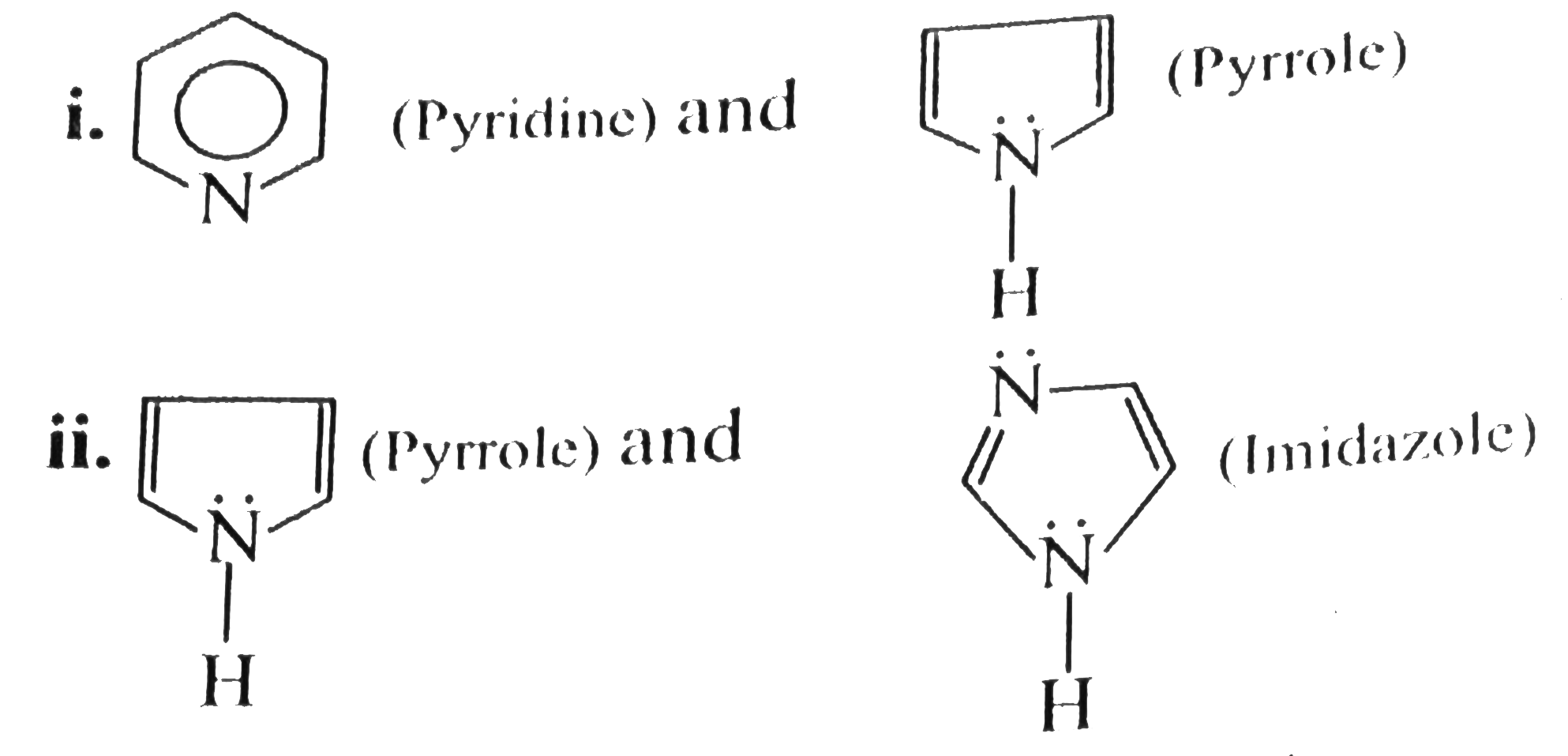
c. Give the decreasing order of teh stability of the following:
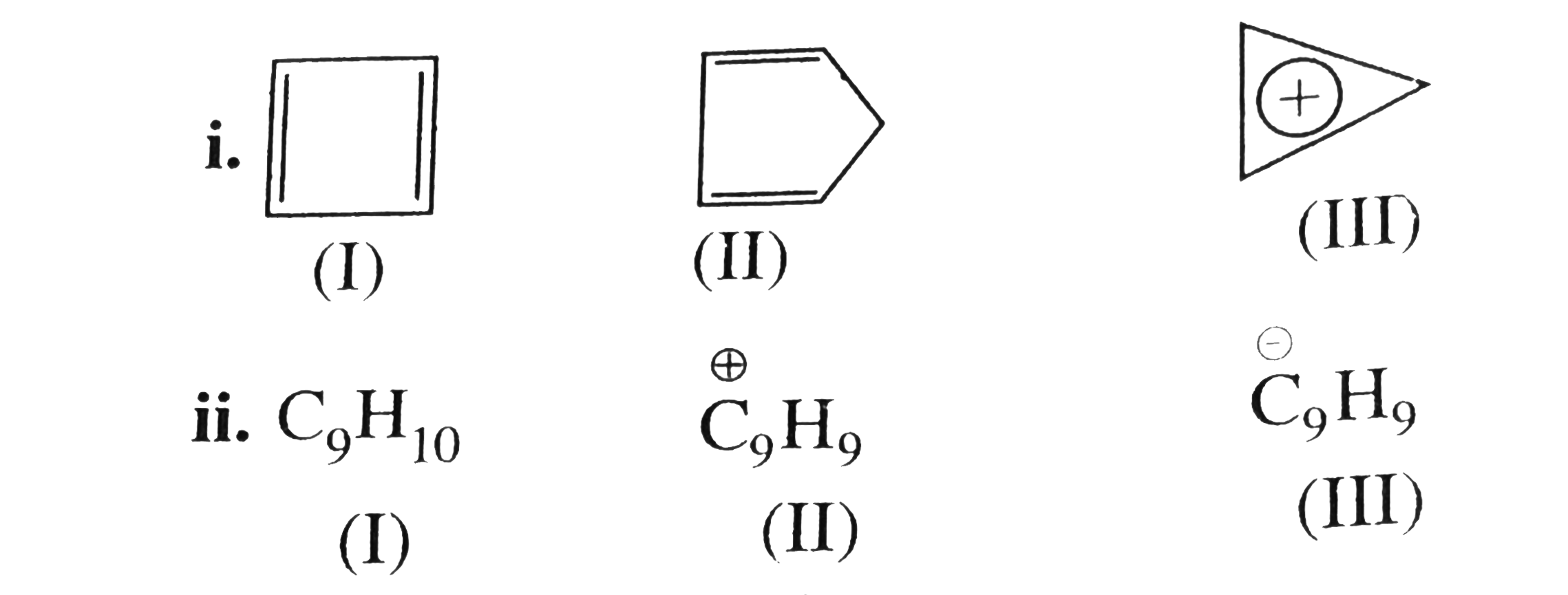
d. Which of the following is more stable?
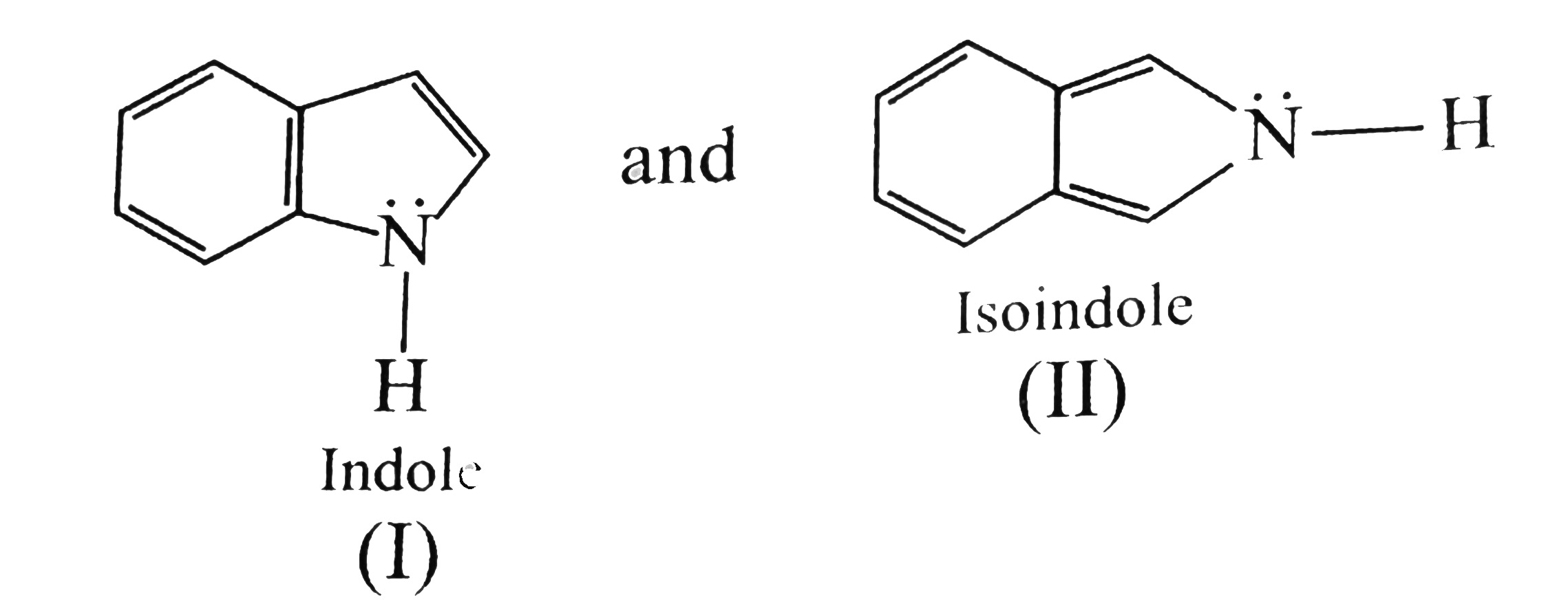
e. What of the decreasing order of `pk_(a)` values of the following?
I. `HC = CH`

f. Which of the following has highest `K_(a)` value?
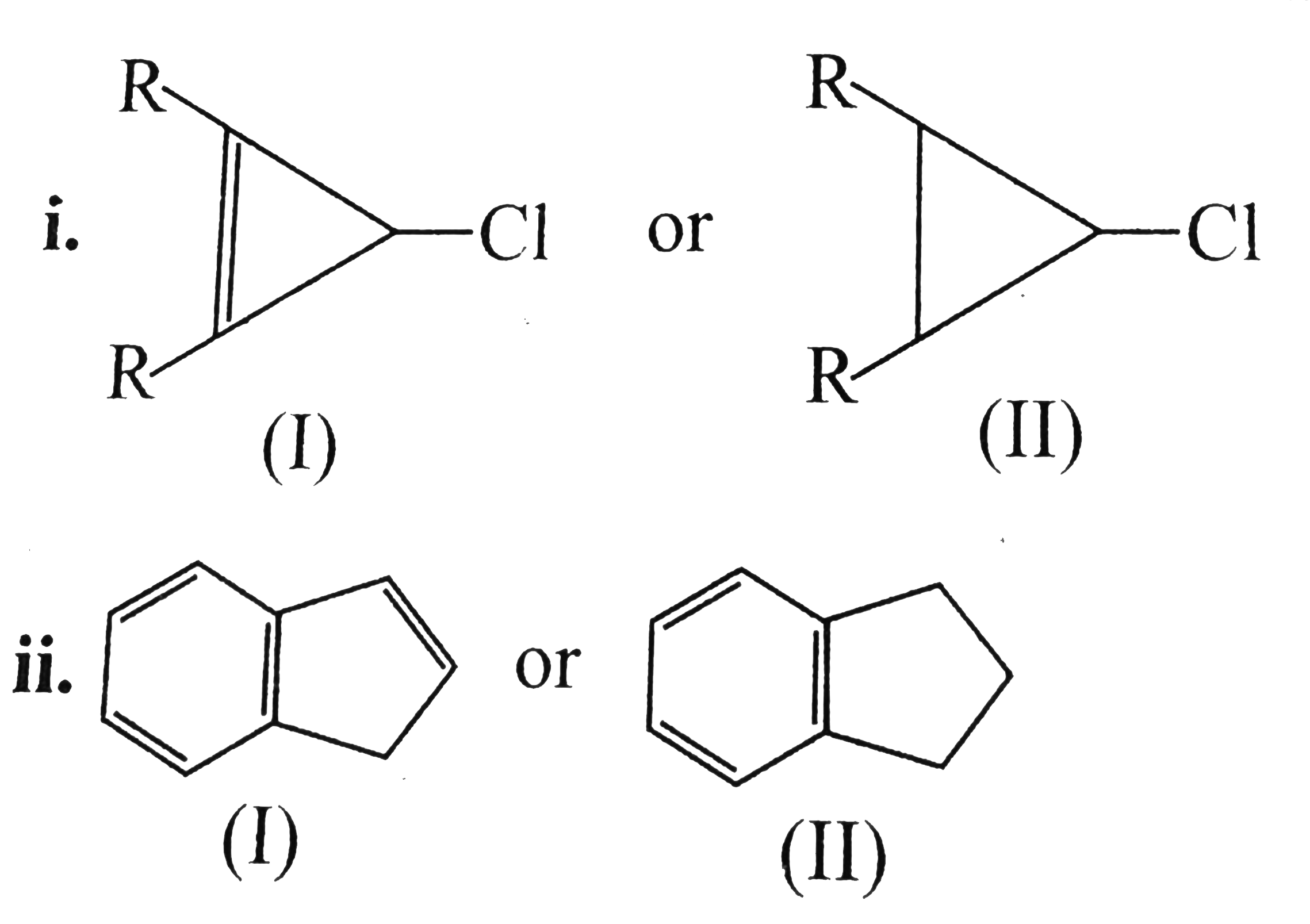
g. Which of the following reacts faster wtih ag. `NaOH` by `SN^(-1)` mechanis,?
 View Solution
View SolutionDistinguish chemically between the following:
i. (a) Cyclohexane, (b) Cyclohexane, (c) Benzene
ii. (a) Benzene, (b ) Naphthalene
iii. (a) Anthrance and (b ) Phenanthrene.View SolutionExpalin the following observations:
a. Benzene is soluble in water whiel both `1,3-` and `1,4-` cyclohexadiene are insouble.
b. Melting point of benzene `(32K)` is much higher than both `1,3-` and `1,4-` cyhexadiences.
c. `P-` Xylene has higher metling point than `o-` and `m-` xylenes.03:09View SolutionSome alternate strucres proposed for benzene are given. Indicate for each of them how many (i) mono and (ii) di-substuted products are possible. Which structures fits in the isomer number observed for benzen?
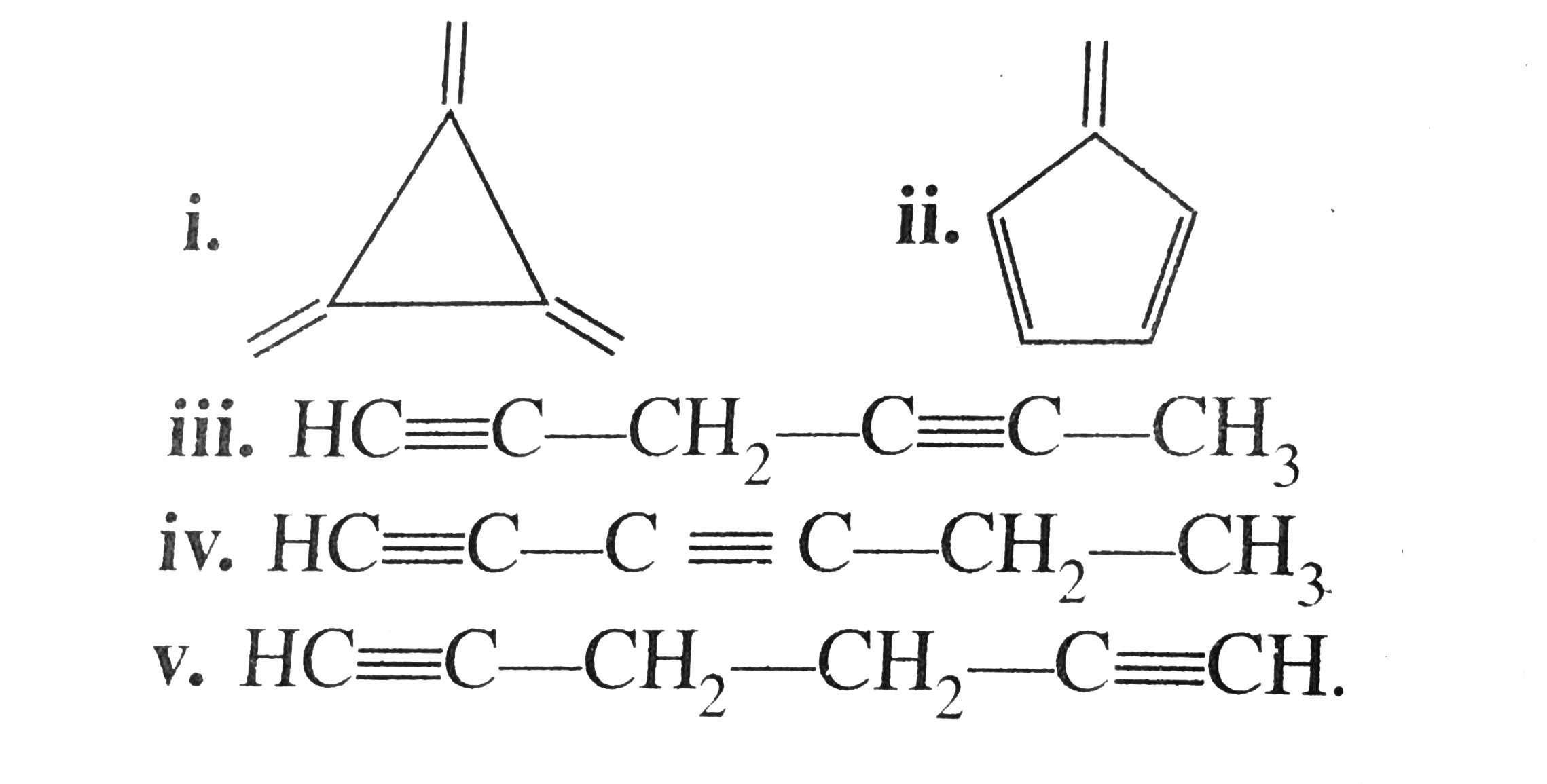
iii. `HC -= C - CH_(2) - C -= C - CH_(2)`
iv. `HC -= C-C -= C - CH_(2) - CH_(3)`
v. `HC -= C - CH_(2) - CH_(2) - C -= CH`.View SolutionArrange the following in decreasing order of `((m)/(o + p))` ratio.
a. I. `PhCH_(3)`, II. `PhCBr_(3)`
III. `PhCHBr_(2)`, IV. `PhCH_(2)Br`
b. I. `PhCH_(3)`, II. `PhCBr_(3)`
III. `PhCCl_(3)`, IV. `PhCl_(3)`
c. I. `ArN^(o+)R_(3)` , II. `ArCH_(2)N^(o+) R_(3)`
III. `ArCH_(2)CH_(2)N^(o+) R_(3)`View SolutionGive the principal product on bromination with `Br_(2)//FeBr_(3)` of the following.
I. `Ph-OCOR`, II. `Ph - CH = CH - NO_(2)`
III. `PhCOONH_(2)`, IV. `Ph-O-Ph`
V. `PhCH_(2)OH`, VI. `PhCoEt`
VII. `Ph - CH = CH - COOH`View SolutionGive the decreasing order of `((o + p)/(m))` ratio for the nitration of compounds in Problem `11.9`.
View SolutionGive major products of the following:
 View Solution
View SolutionGive the decreasing order of `(o+p)/(m)` ratio of the reactions or decreasing order of the reactivity given is problem `11.11`.
View Solution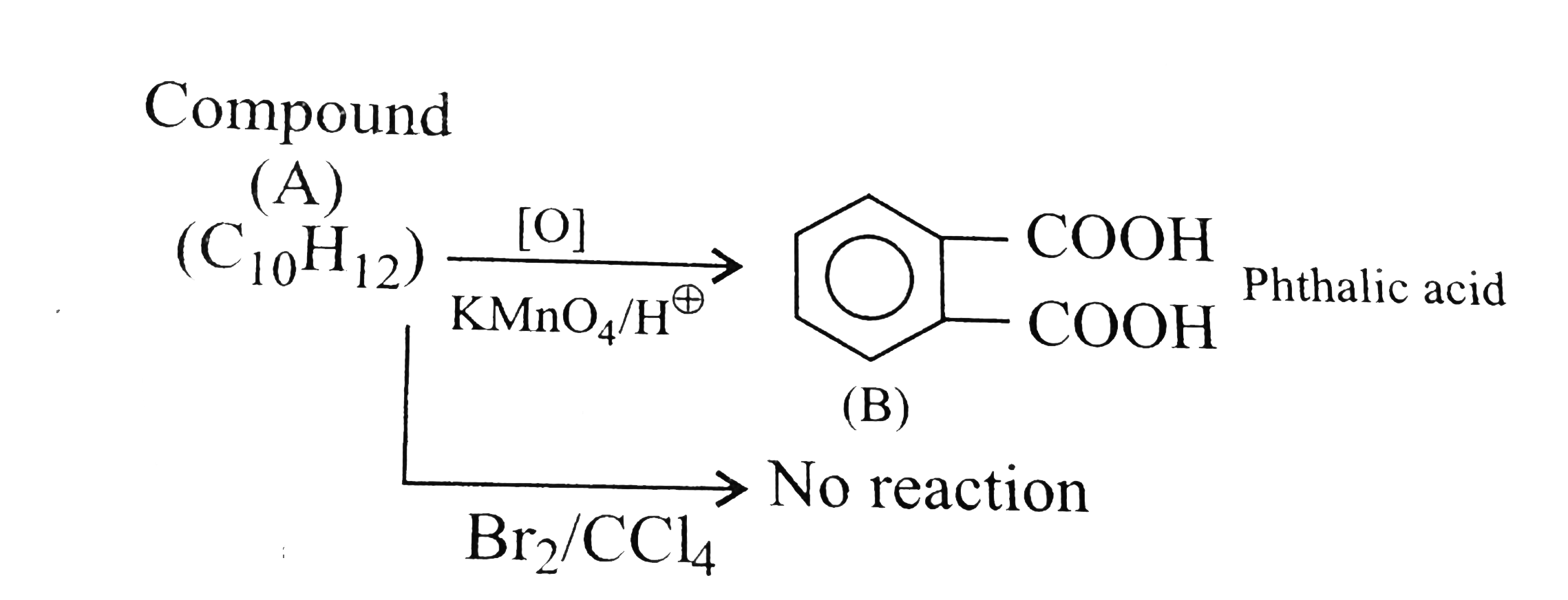
Identify compound `(A)` How many isomers including geometrical isomers are possible for `(A)` ?05:44View SolutionIdentify `(A)`.
 03:58View Solution
03:58View SolutionGive the products of the following:
i. Benzene + Cylohexanol `(BF_(3), 60^(@)C)`
ii. Benzene `+ CH_(2) = CHCH_(2)Cl (ZnCl_(2))` and `H_(2)SO_(4)`
iii. Benzene `+` Ethylene oxide `+ AlCk_(3)`
iv. Benzene `+ CH_(2)Cl_(2) + alCl_(3) rarr (A)`
`(B) overset(C_(6)H_(6) + AlCl_(3)|)(larr)`
v. Benzene `+ ClCH_(2)CH_(2)Cl + AlCl_(3) rarr (C)`
`(D) overset(C_(6)H_(6)+ AlCl_(3)|)(larr)`
vi. Benzene + Phosgene `(COCl_(2)) overset(AlCl_(3))(rarr) (E)`
overset(H_(3)O^(o+))(rarr) (F)`
vii. Toulene + Malonci anthydride `overset(AlCL_(5)(rarr) (A)`
`underset(H_(3)PO_(4))(rarr) (B) underset(HCl) overset(Zn-Hg)(rarr) (C)`
viii. Explain how alkyl benzene naphalene, anthracene and phenanthrene can be distinguished form one another `F.C.` reaction ?View Solutiona. Show that reaction of `o-` bromogluro benzene with `Mg` produces benzyene.
b. Why does `I-` cj,prp`-2.6-` dimerhyl benzene not undergo elimination-addition reaction with `NaNH_(2)` in liq. `HN_(3)`?
c. Why does bromobenzyene react faster than `2.6-` dideuteriobromonbenzene with `NaNH_(2)` in liw. `NH_(3)`?
In the following reactions:

Explain why the formaiton of `(I)` is faster than that of `(II)`.
c. Why does compound `(A)` on heating give benzyene intermediate which dimeries to give product `(B)`.
 View Solution
View SolutionWhen three isomeric chlorotounes are treated with `KNH_(2)` in liquid `NH_(3)`, they yield different toluidines as shown below. Explain these observations. ltrgt a. `o-` Chlorotouene `rarr (o : m)-` Toluidine
b. `m-` Chlorotouene `rarr (o + m + p)-` Touidine
c. `p-` Chlorotouene `rarr (m +p)-` TouidineView SolutionGive the order of reactivity towards `SN^(2)` reaction of the followig:
a. i. `1-` Bromopentane
ii. `2-` Bromopenatane
iii. `2-` Bromo `-2` methyl butane
b. i. `n-` Butybromide `(C_(4) H_(9) Br)`
ii. Isobutyl bromide `Me_(2) CHCH_(2)Br`
iii. `sec-` Buityl bromnide `CH_(3) - CH(Me) CH_(2)Br`
iv. tert- Butyl bromide `Me_(2)C-Br`View SolutionGive the order of reactivity towards `SN^(1)` reaction of the followig:
a. i. `1-` Bromopentane
ii. `2-` Bromopenatane
iii. `2-` Bromo `-2` methyl butane04:41View SolutionGive the order of `SN^(-1)` of `SN^(-1)` and `SN^(2)` displacement of halogen `CH_(3)X, 1^(@X, 2^(@)X, 3^(@)X`.
05:07View SolutionGive the order of reactivity towards `E2` dehydrohalo-genation of the following.
a. i. `C_(2)H_(5)Br`
ii. `C_(3)H_(7)Br`
iii. Isobutyl bormide
iv. Neopentyl bromide
b. i. `2-` Bromo `-2-` methybutane
ii. `1-` Bromo pentane
iii. `2-` Bromo pentane
iv. `3-` Bromo pentane09:10View SolutionGive the order of reactivity towards `SN^(-1)` solvoloysis of the following:
i. Benzyl chloride
ii. `p-` Chlorobenzyl chloride
iii. `p-` Methoxbenzyl chloride iv. `p-` Methyl benzyl chloride
v. `p-` Nitrobenzyl chloride03:48View SolutionGive the order of reactivityh towards `SN^(1)` reaction of the following:
i. `ClCH_(2)CH = CH_(2)`
ii. `CH_(3)CH_(2)CH_(2)Cl`
iii. `CH_(3)CH = CHCl`02:44View Solution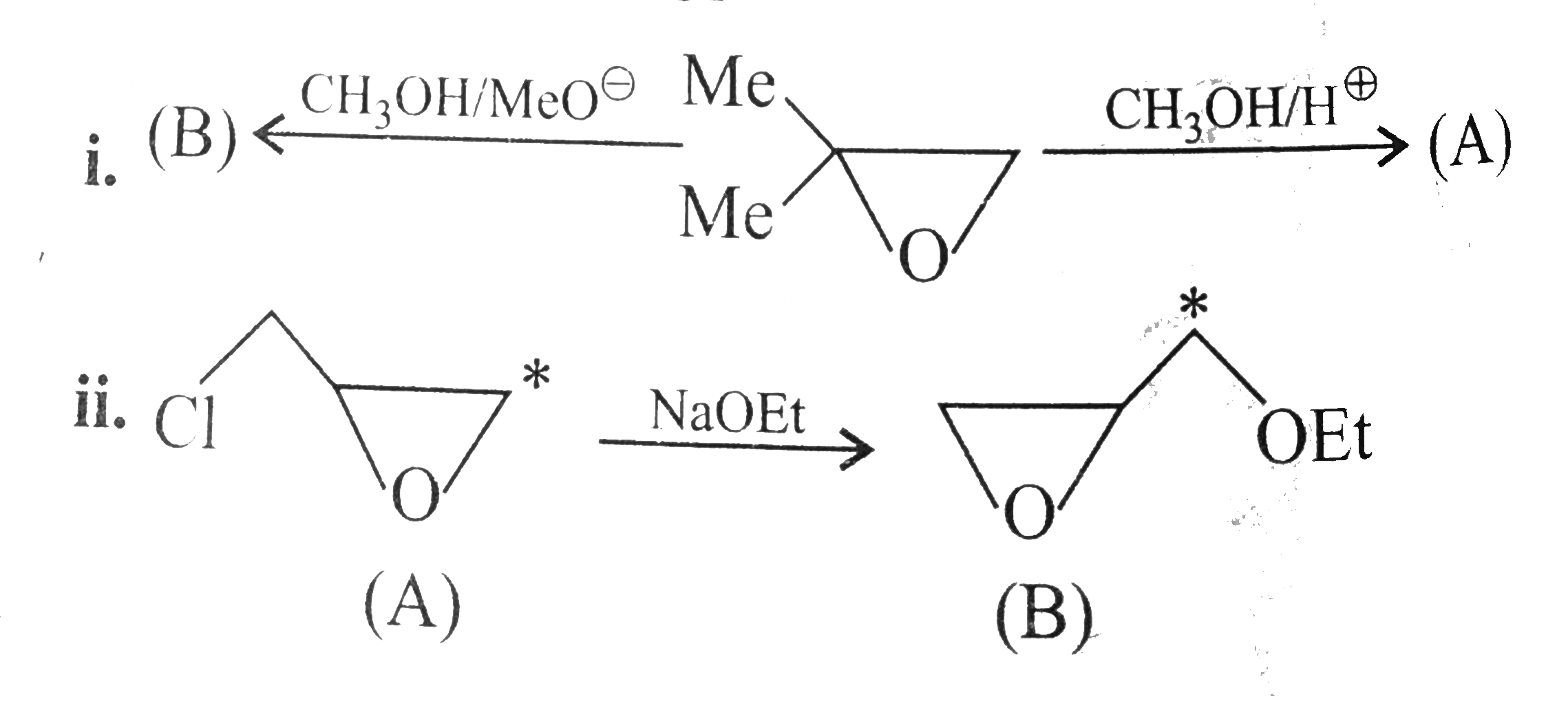 View Solution
View Solution View Solution
View SolutionOutline the preparationof the following compounds using a nucliphileic subsituationr reaction.
a. `CH_(3)OC(CH_(3))_(3)`
b. `CH_(3)C -= CCH_(2)CH_(3)`
c. `CH_(3)CH_(2)CH_(2)N (CH_(3))_(2)`
d. `C_(6) H_(5)CH_(2) OCOCH_(3)`
e. `CH_(3)CH_(2)CH_(2)CH_(2)NO_(2)`
f. `CH_(3)CH_(2)CH_(2)Cn`
g. `C_(6) H_(5) CH_(2) N^(o+) -= C^(o-)`
h. `CH_(3)CH_(2) - O - N = 0`View SolutionWhich compound in each of the following paris will react faster in `SN^(2)` reaction with `HO^(o-)` ?
a. CH_(3)Br` or `CH_(3)I`
b. `(CH_(3))_(3)CCl` or `CH_(3)Cl`
c. `CH_(2) = CHBr` or `CH_(2) = CH - CH_(2)Br`05:42View SolutionArrange the folliwing compounds in increasing order of `SN^(-2)` reactivity.
a. I.m `ClCH_(2)CH = CHCH_(2)CH_(3)`
II. `CH_(3)C(Cl) = CHCH_(2) CH_(3)`
III. `CH_(3)CH = CHCH_(2)CH_(2)Cl`
IV. `CH_(3)CH = CHCH_(2)(Cl) CH_(3)`
b. I. `CH_(3)CH_(2)Br`
II. `CH_(2) = CHCH(Br) CH_(3)`
III. `CH_(2) = CHBr`
IV. `CH_(3)CH (Br) CH_(3)`
C. I. `(CH_(3))_(3)CCl`, II. `C_(6)H_(5)C(CH_(3))_(2)Cl`
III. `(CH_(3))_(2)CHCl`, IV. `CH_(3)CH_(2)CH_(2)Cl`06:00View SolutionPredict all the alkenes that would be formed by dehydrohalogenation of the following halides with sodium ehoxide in ethanol and indentify major alkene.
a. `I-` Bromo `-1-` mehylecyclohexane
b. Chcolhexylmethyl bromide
c. `2-` Chloro `-2-` ilutane
d. `3-` Bromopent `1-` ene
e. `2,2,3-` Trimethyl `3-` bromopentane.07:44View SolutionPredict all order of reactivity of the following compounds in dehydrohalogenation.
a,. I. `CH_(3)CH_(2)CH_(2)CH_(2)Cl`
II. `(CH_(3))_(2)CHCH_(2)Cl`
III. `(CH_(3))_(2)CH - CH_(2)Br`
IV. `CH_(3)CH(Br)CH_(2)CH_(3)`
V. `(CH_(3))_(3) C - Br`
b. I. `CH_(3)CH(Br)CH_(3)`
II. `CH_(3)CH_(2)CH_(2)Br`
III. `(CH_(3))_(2) CH - CH_(2) Br`
IV. `(CH_(3))_(3)C - CH_(2) Br`View SolutionExplain :
a. Vinyl chloride is unreactive in nucliphillic `4-` subsitution reactions.
b. Neopenthyl bromide undergoes nucliphillic substituion reactions very slowly.
c. `3-` Bromocyclohexane is more reactive than `4-` bromovyclohexane in hydrolysis with aqueous `NaOH`.
d. `ter-` Butyl chloride reacts with aqueous sodium hydroxide by `SN^(1)` mechanishm while `n-` butuyl chloride reacts by `SN^(2)` medchanism.View SolutionThe nucliphilic substituation of primary alkyl chlorides wityh sodium acetate is cataysed by sodium iodide. Explain why.
02:28View SolutionArrange the folliwing halides in order of increasing `SN^(2)` and `SN^(1)` reactions.
I. `CH_(3)Cl` , II. `CH_(3)Br`
III. `CH_(3)CH_(2)Cl` , IV. `(CH_(3))_(2)CHCl`04:14View SolutionPredicrt the order of reactivity of the following compounds in `SN^(1)` and `SN^(2)` reactions.
 04:13View Solution
04:13View SolutionPredict the order of reactivity of the folloiwing compoundss in `SN^(1)` and `SN^(2)` reacations.
a. The four isomeric bromolbutanes
b. I. `C_(6)H_(5)CH_(2)Br`
II. `C_(6)H_(5) CH (C_(6) H_(5)) Br`
III. `C_(6)H_(5)CH (CH_(3) Br`
IV. `C_(6)H_(5)C(CH_(3)(C_(6) H_(5)) Br`View SolutionIdentify all the possible alkenes that would be formed on the dehydrohalogenation of the following organic halides with alcoholic `KOH`. Also, identify the major alkene.
a. 1- Chloropentane
b. 2- Chloropentane
c. 2-chloro-2-methyl butane
d. 2-Chloro-3-methyl butane
e. 3- Chloro-2-methyl pentane06:56View SolutionI. Which compound has the fasterct rate of reaction with `HCl` ?
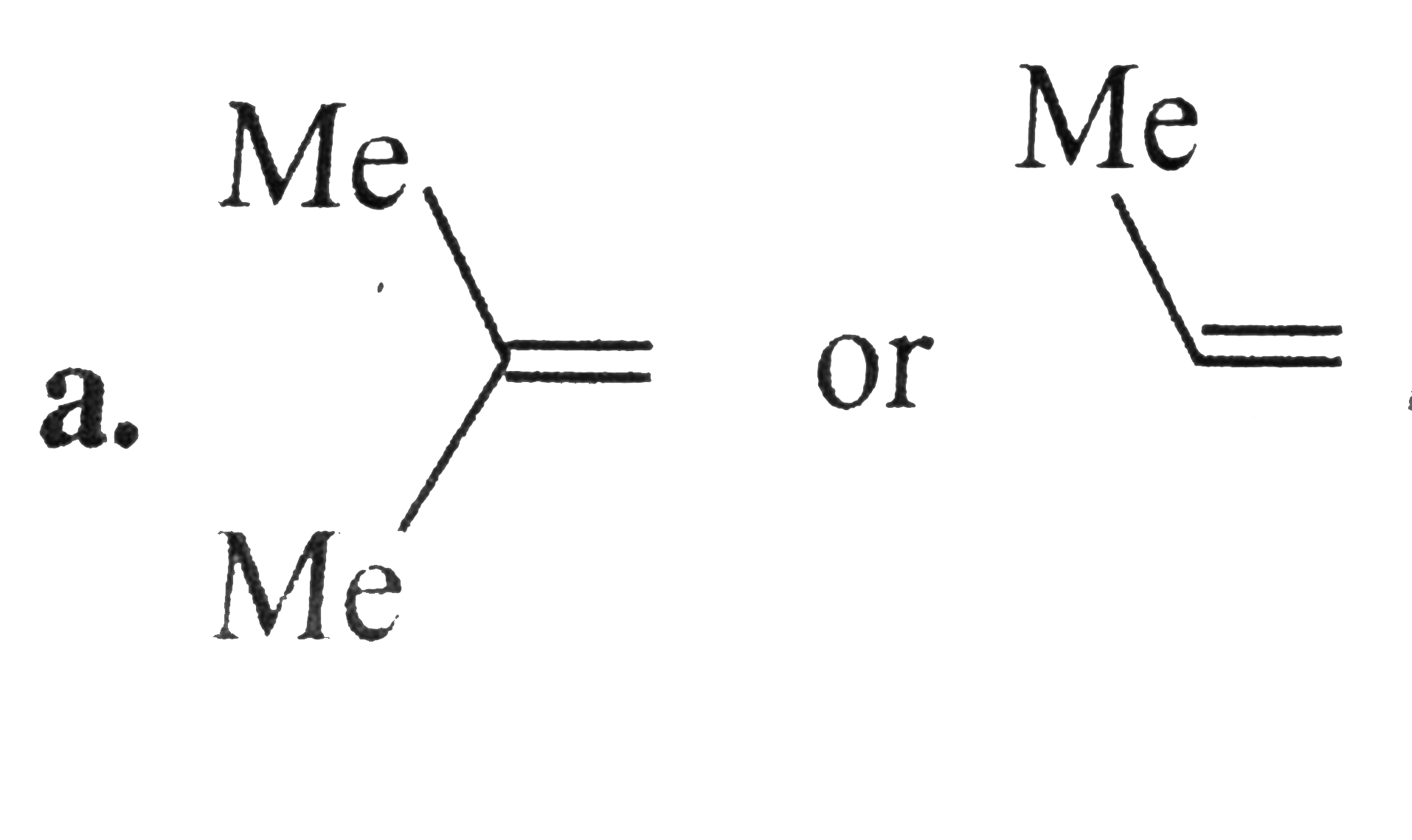
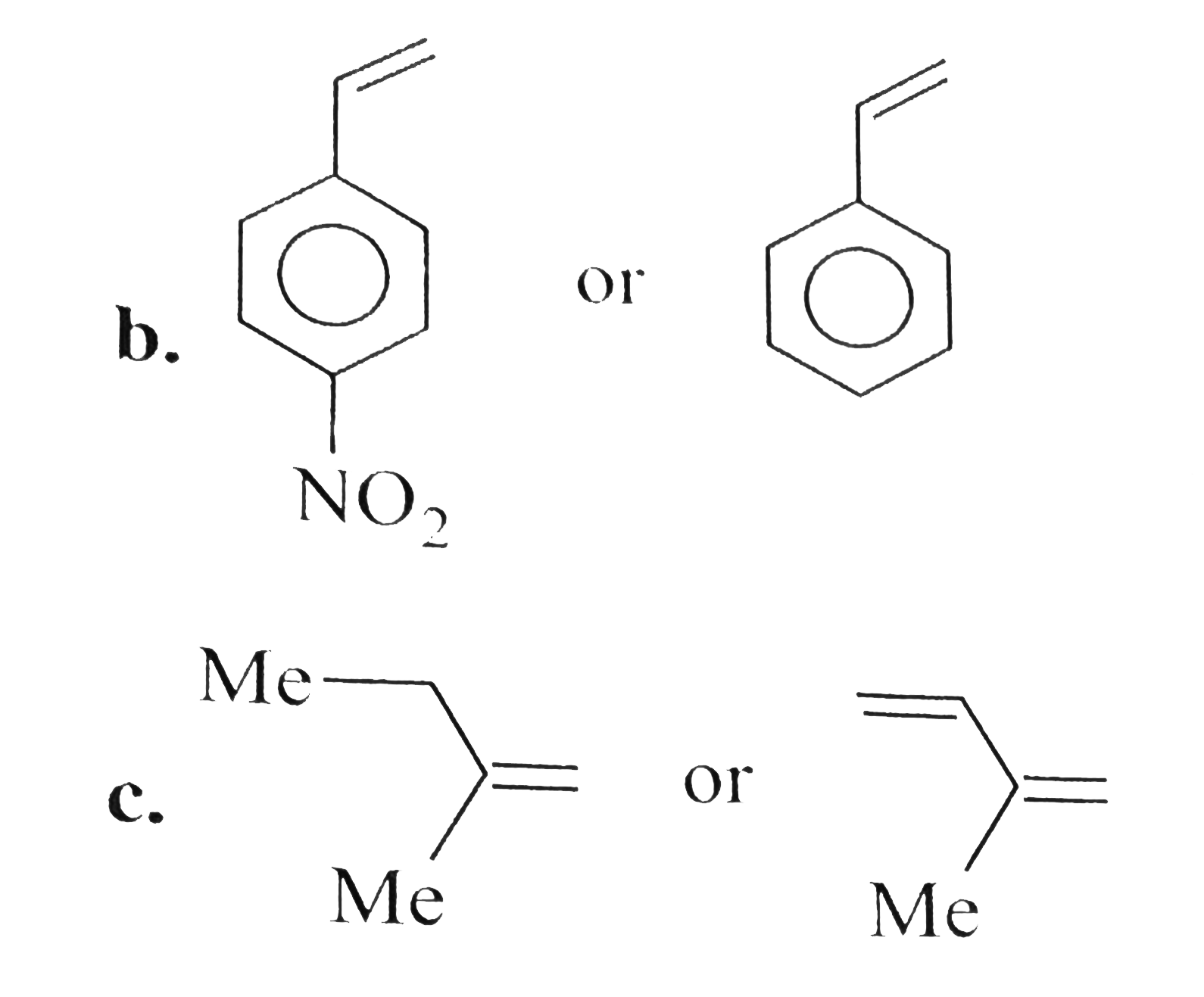
II. Two compounds `(C_(8)H_(15)Br)` are formed when `1.6-` dimethycycothexene reacts with `HBr` in dark and are formed from `1.2-` dimethylcyclohexene. What are these two compounds?
III. A hydrocarbon `(Mw = 70)` gave only on monochloro-derivatives on photochemical chlorination. Name both the compound.
IV. Among the isomerc alkanes of `MF (C_(5)H_(12))` identify the one that on photochemical chlorination yields:
a. A single monochloride
b. Three isomeric derivaties
c. Four isomeric derivatiesView Solution
Solved Problems questions and complete solutions for chapter AROMATIC COMPOUNDS AND ALKYL AND ARYL HALIDES of CENGAGE CHEMISTRY (HINGLISH) of Class 12
All Exercises from CENGAGE CHEMISTRY Class 12 CHEMISTRY AROMATIC COMPOUNDS AND ALKYL AND ARYL HALIDES
- Archives Assertion-Resoning
- Archives Fill In Theblanks
- Archives Mutiple Correct
- Archives Mutiple Correct Answers Type
- Archives Single Correct
- Archives Single Correct Answer Type
- Archives Subjective
- Archives Subjective Type
- Exercises Assertion-Resoning
- Exercises Assertion-Resoning Type
- Exercises Concept Application
- Exercises Concept Application Type
- Exercises Linked Compreshension
- Exercises Linked Compreshension Type
- Exercises Multiple Correct
- Exercises Multiple Correct Answers Type
- Exercises Single Correct
- Exercises Single Correct Answer Type
- Exercises Subjective
- Exercises Subjective Type
- Illustration
- Solved Examples
- Solved Problems
